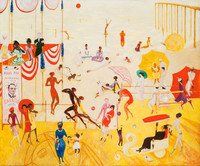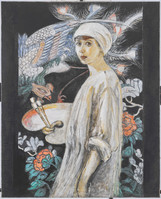New Stettheimer exhibition offers fresh perspective of ‘underknown’ artist
In 1916, painter Florine Stettheimer held a showing of her work at the prestigious Knoedler Gallery in Manhattan. However, it turned out to be a professional and personal disappointment for the artist.
The evening attracted tepid press reviews, and not a single work was sold. It would be the last time Stettheimer held a solo showing of her work. Instead, she displayed her pieces at society parties and artist salons, attracting the leading names of the day like Georgia O’Keeffe and Alfred Stieglitz.
Things are different now, especially at the Jewish Museum in Manhattan, which is giving Stetthimer her first major American exhibition in 20 years with “Florine Stettheimer: Painting Poetry.”
“Stettheimer has sometimes been typecast as a lightweight feminine artist with a whimsical bent,” said Stephen Brown, the museum’s associate curator who helped organize the exhibition. “This view is belied by her powerful thinking of portraiture and her astute adaptation of European vanguard ideas, most notably symbolism, to a uniquely American imagery. Stettheimer’s carefully crafted and exuberant paintings reveal her most distinctive artistic techniques: The use of strong colors and the mixture of realistic settings with dramatic, even surrealistic, elements.”
Paintings such as 1918’s “Picnic at Bedford Hills” draw from folk art and art-deco fashion illustration to give a carefree and joyous feel as Stettheimer, her family and friends enjoy the afternoon. Stettheimer’s sister Carrie, artist friend Marcel Duchamp, sculptor Elie Nadelman, and Stettheimer’s other sister Ettie, are sprawled on the grass.
Others such as 1920’s “Asbury Park South” pack sly wit and social commentary into oil on canvas. Using bright yellows and vibrant reds, the scene shows wealthy whites and African-Americans enjoying a day at the beach in Asbury Park, New Jersey. While this scene might fit into what some would imagine happens on the beach today, it was pretty risqué nearly a century ago when Asbury Park was a segregated beach.
Bold colors, fashion-illustration style images and ladies posed throughout the scene looking at handbags, dresses and scarves capture the scene of a clothing sale at Henri Bendel, an upscale New York department store in 1921’s “Spring Sale at Bendel’s.”
The show includes “Portrait of My Mother,” which Stettheimer painted in 1925. It is one of her lesser-known works, and one of Brown’s favorites.
“It belongs to a series of female role models (aunt, mother, teacher… ) in Stettheimer’s life, and it shows her detailed painterly technique,” he said.
“While (living) in Europe, she came under many influences, such as Jugendstil and post-impressionism, along with the great art of the past, from Rome to the Florentine Renaissance, from Botticelli to Titian to Velazquez.”
Symbolism had the most profound effect on Stettheimer's pieces.
“Her work is comedic and philosophical,” Brown added, “hinging on the great issues addressed by all great art: time, love, death, and the power of art over life.”
“Painting Poetry” showcases 50 paintings and drawings by Stettheimer as well as, her sculptures. Seven of her poems are featured along the gallery walls, covering topics such as her likes and dislikes, food and nature. Only a few of her family and friends even knew of Stettheimer’s poetry writing, the museum claims.
Additionally, the exhibition shows the more than one dozen costume and set designs by Stettheimer for the groundbreaking opera “Four Saints in Three Acts” by Virgil Thomson and Gertrude Stein. It featured an all African-American cast.
Stettheimer was born in 1871 in Rochester, New York. She studied at the Art Students League in New York City and later in Europe.
Stettheimer came from a wealthy Jewish family, but encountered two strong influences, which made a major impact on her work — the symbolist painters and poets, and the Ballets Russes. She, along with her sisters Carrie and Ettie, and mother Rosetta, lived an affluent and well-traveled lifestyle, allowing Stettheimer to spend time studying her craft full-time.
They spent many years living, studying and traveling in Europe before returning to New York for good in 1914 at the outbreak of World War I, Brown said. She died in 1944.
The Jewish Museum last showed Stettheimer’s work as part of a group exhibition called “The Power of Conversation: Jewish Women and Their Salons” in 2005, Brown said. The current showing is done in partnership with the Art Gallery of Ontario in Toronto, which will display Stettheimer’s works in October after it leaves New York.
“Florine Stettheimer is an underknown artist whose work requires further study,” Brown said. “This exhibition allows the public to enjoy and appreciate the artist’s outstanding achievement.”









